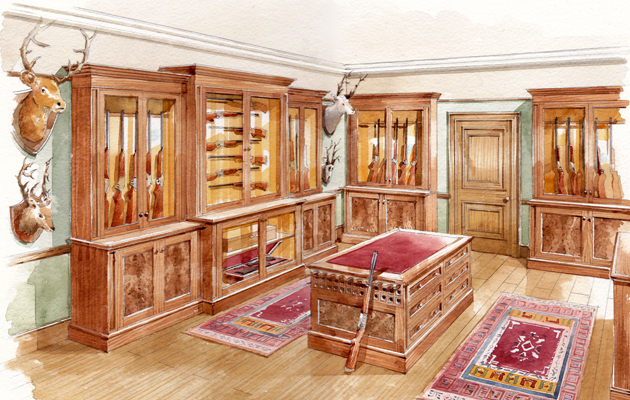'You can tell a Purdey person when out shooting - they’re understated, not flash'
If you’re lucky enough to visit Audley House, James Purdey & Sons’ emporium on Mayfair’s South Audley Street, which has been home to the distinguished gunmaker since 1883, you’ll witness first hand the rich history bound up in its walls.
Established by James Purdey in 1814 – whose family was at the helm until 1948, when the Beaumont family bought it, followed, in 1994, by the Richemont Group – Purdey is one of the most respected and luxurious companies in the world.
It has no less than three Royal Warrants and its chairman, James Horne, regaled me with a story of a pair of miniature shotguns (one-sixth of the usual size) that Purdey made for George V, who, when bored at dinner parties, used to slope off, armed with his diminutive firearms and a candle, to shoot moths attracted to its light – just one of the many tales proving the extraordinary skill of the company’s craftsmen.
Still proudly made in Britain, by a 50-strong workforce based in the company’s Central London factory, Purdey’s bespoke guns are lovingly crafted by its gunsmiths – many of whom have worked there for 40–50 years – with each model taking two years (12,000 hours) from start to finish.
Indeed, the process is so careful and precise that Purdey clients are actively encouraged to be part of the procedure so they can understand the complexity of building a shotgun. ‘You’re buying something really special and part of that delight is going to meet the craftsmen and seeing them produce the various parts,’ enthuses Mr Horne.
The ‘Purdey way’ sees clients meet their craftsman, choosing pieces of wood (walnut for stocks), their engraver and the style of that engraver’s work. Some keep it classic, with a rose and scroll, and others let their imagination run wild, with dogs, a favourite patch of countryside or a likeness of their wife. One client even chose to depict Margaret Thatcher.
‘Shooting has changed beyond all recognition,’ explains Mr Horne, founder of Guns On Pegs (which buys and sells game shooting online). ‘High-bird shooting has become so in vogue, you need a gun to handle that.’
It’s clear that Purdey can provide the lot, including a ‘monster weekend bag’ that I have my eye on, which ‘effortlessly takes all the things you need, as well as all the things you don’t, but can’t live without’, including cigar and drinking apparatus and your gun, of course – although you may need someone else to carry it for you.

James Horne’s three top tips for keeping guns in perfect condition
- Dry your gun carefully when it gets wet – never put it on the Aga, as the way the wood expands and contracts due to the heat will cause all sorts of untold problems. It is a natural material after all.
- Use a cloth to remove beads of water – guns are made of steel, so they do rust – and oil the stock judiciously, but don’t overdo it. If you know it’s going to rain on a shoot day, take a spare, dry slip, into which you’ll be able to place the gun at the end, once it’s dry.
- Many people store their guns by stacking them on the stock, with the barrels pointing upwards. However, when it’s wet, it’s best to stand the shotgun (carefully) on the tips of the barrels with the stock at the top, so that oil and water don’t run into the action.

Glorious gun rooms
Country Life looks at the function and form of the gun room, and asks the experts about their ideal set

The joy of rough shooting
In pursuit of a truly mixed bag, Adrian Dangar goes rough shooting in Co Durham.

Beginner’s guide to clay pigeon shooting
We outline our tips for new shots hoping to become top gun.





